ADV 275 Final
0.0(0)
Card Sorting
1/112
Earn XP
Description and Tags
Study Analytics
Name | Mastery | Learn | Test | Matching | Spaced |
|---|
No study sessions yet.
113 Terms
1
New cards
1. centralized market
2. economy where supply>demand (sell surplus)
• As people started manufacturing more… industrialism → rise of advertising
2. economy where supply>demand (sell surplus)
• As people started manufacturing more… industrialism → rise of advertising
2 Key Forces causing rise of advertising
2
New cards
“Half of all my advertising is wasted. I just don’t know which half.”
• It's why we study advertising
• It's why we study advertising
John Wannamaker quote
3
New cards
U.S. alone = 1/2 of all advertising in the world
• u.s. - 300-400 B
• global - 700-900 B
• u.s. - 300-400 B
• global - 700-900 B
Advertising – US and Global spending
4
New cards
creating demand for products (generating customers)
Marketing as “demand creation”
5
New cards
Exchange: involves 2/more parties
• communication needed to sell
• something of value to one another
- Company & service gets money
- Customer gets good service/company
• communication needed to sell
• something of value to one another
- Company & service gets money
- Customer gets good service/company
Marketing as “exchange”
6
New cards
tons of stuff fall under marketing
- advertising
- PR
- events
- promotion
- POP
- brand identity
- Social Media
- product mgt.
- advertising
- PR
- events
- promotion
- POP
- brand identity
- Social Media
- product mgt.
Marketing as “umbrella”
7
New cards
• Price is never the issue… it’s VALUE
- Advertising builds value
- Advertising builds value
Benefits + Cost = Value
8
New cards
paid, placed, & purposeful communication w/ the intent of persuasion
Advertising definition
9
New cards
COORDINATION & INTEGRATION of all marketing communications into a seamless program designed to maximize the effect of customers & to stakeholders
IMC definition
10
New cards
Planned process to influence; not paid placement, uses 3rd party endorsement
PR definition
11
New cards
Product, Price, Place, Promotion
• advertising focuses on PROMOTION
• advertising focuses on PROMOTION
4 P's of the Marketing Mix
12
New cards
• brands: company owns several
• branding: creating logos/colors/audio logos like commercial songs
• identity: look/character of brand (tiffany co = tiffany blue)
• equity: add/subtract brand value
- better the brand = more ppl like it = more equity/value to the company
- ex. Coke machine (expensive) vs Walmart coke (cheap)
- It’s measurable
• parity: copy of another brand
• branding: creating logos/colors/audio logos like commercial songs
• identity: look/character of brand (tiffany co = tiffany blue)
• equity: add/subtract brand value
- better the brand = more ppl like it = more equity/value to the company
- ex. Coke machine (expensive) vs Walmart coke (cheap)
- It’s measurable
• parity: copy of another brand
Brands, Branding, Brand Identity, Brand Equity, Brand Parity
13
New cards
similar to 7 pillars of IMC???
Promotional Mix
14
New cards
1. Advertising
- broadcast
- print
- OOH
- mail
- directory
- internet
2. PR
- media
- government
- relationship management
- crisis management
3. Non-Advertising Promotion (not always purposeful & placed)
- discounts
- coupons
- sponsorships
- giveaways
4. Personal Selling
- salespeople
- telemarketing
- customer service
- tech support
5. Events/Experiential
- trade shows
- sampling
- test drives
- invite events
6. Social Media
- owned sites
- earned sites
- crowd sourced
7. All Other
- packaging
- branding
- POP
- content marketing
- broadcast
- OOH
- directory
- internet
2. PR
- media
- government
- relationship management
- crisis management
3. Non-Advertising Promotion (not always purposeful & placed)
- discounts
- coupons
- sponsorships
- giveaways
4. Personal Selling
- salespeople
- telemarketing
- customer service
- tech support
5. Events/Experiential
- trade shows
- sampling
- test drives
- invite events
6. Social Media
- owned sites
- earned sites
- crowd sourced
7. All Other
- packaging
- branding
- POP
- content marketing
7 Pillars of IMC
15
New cards
national: nationwide basis or most regions of country
retail/local: shop @specific store, local service
retail/local: shop @specific store, local service
national/regional/local advertising
16
New cards
business-to-business (aka trade advertising)
business-to-customer
business-to-customer
B2B & B2C
17
New cards
direct marketing: communicating directly w/ target customers
- ex) emails, interactive social media
• NEW concept of omnichannel: ability of company to sell product/service through multiple diff platforms
- Brick & mortar store = term for physical store
- Click & mortar = both physical & online
- Pure play = online
• provides extensive database of customer names & info
brand awareness meant to build trust in brand while direct marketing is meant to drive a specific action.
- ex) emails, interactive social media
• NEW concept of omnichannel: ability of company to sell product/service through multiple diff platforms
- Brick & mortar store = term for physical store
- Click & mortar = both physical & online
- Pure play = online
• provides extensive database of customer names & info
brand awareness meant to build trust in brand while direct marketing is meant to drive a specific action.
Direct Marketing & Direct Response vs Brand Awareness
18
New cards
• Ad = touch point for people see/hear/experience brand or company
- unexpected: unexpected info customer finds w/o trying (WOM, viral)
- customer-initiated: direct experience w/ brand (ex. call w/ representative)
- intrinsic: knowing what you want; consumer buys
- company created: planned marketing messages
control (x) impact (y)
high to low diagonal line
- unexpected: unexpected info customer finds w/o trying (WOM, viral)
- customer-initiated: direct experience w/ brand (ex. call w/ representative)
- intrinsic: knowing what you want; consumer buys
- company created: planned marketing messages
control (x) impact (y)
high to low diagonal line
Touch Point – company created, intrinsic, unexpected, customer-initiated
19
New cards
P: advertising (TV, radio, magazines, etc)
O: website, youtube channel, blog (your own, controlled channel)
E: WOM, reviews, comments
NEW … shared media
- Social media
- company posts on instagram (owned)... person comments (earned)
O: website, youtube channel, blog (your own, controlled channel)
E: WOM, reviews, comments
NEW … shared media
- Social media
- company posts on instagram (owned)... person comments (earned)
Paid Media, Owned Media, Earned Media
20
New cards
creation & data combined
Art vs Science of Advertising
21
New cards
1) Vision, Mission, Goals, Objectives (vee-mo = vgmo)
vision = future; what we want to become
mission = purpose; values (what's being done)
goals = desired outcome
objectives = specific actions & timelines for achieving goal
2) business plan
3) marketing plan
4) advertising plan
vision = future; what we want to become
mission = purpose; values (what's being done)
goals = desired outcome
objectives = specific actions & timelines for achieving goal
2) business plan
3) marketing plan
4) advertising plan
Advertising in Marketing Context
22
New cards
Problem = need/want
Opportunity = solution
- can be so new that it GIVES opportunity (ex. ipod)
• market opportunity is where
- Favorable demand trends
- Customers’ needs/opportunities NOT satisfied
- Firm can compete effectively
Opportunity = solution
- can be so new that it GIVES opportunity (ex. ipod)
• market opportunity is where
- Favorable demand trends
- Customers’ needs/opportunities NOT satisfied
- Firm can compete effectively
Problems & Opportunities (analysis)
23
New cards
segment market (group/categorize)
--> target segment (choose one)
--> position product to segment
--> communicate positioning via advertising
--> target segment (choose one)
--> position product to segment
--> communicate positioning via advertising
Target Marketing Process
24
New cards
segment: dividing market into distinct groups w/ similarities
target: determine how many segments to enter (undifferentiated, differentiated, concentrated) & choose ones with most potential
targeting: ^act of doing
positioning: fitting product/service to segment(s) to make it unique in broad market
target: determine how many segments to enter (undifferentiated, differentiated, concentrated) & choose ones with most potential
targeting: ^act of doing
positioning: fitting product/service to segment(s) to make it unique in broad market
Segment, Target, Targeting, Positioning
25
New cards
Geographic: location (region, city, size, metropolitan, density)
Demographic: quantifiable measurements of people (age, income, gender, married)
Psychographic: Lifestyle, feelings, thoughts, harder to quantify (personality)
Technographic: how consumer interacts w/ technology (how they pay; mobile or online shopping?)
Buyer Behavior: how many they buy (pack or single)... how often... etc.
Demographic: quantifiable measurements of people (age, income, gender, married)
Psychographic: Lifestyle, feelings, thoughts, harder to quantify (personality)
Technographic: how consumer interacts w/ technology (how they pay; mobile or online shopping?)
Buyer Behavior: how many they buy (pack or single)... how often... etc.
Selecting a Target Audience (5)
26
New cards
1. Greatest Generation
- war times
2. Baby Boomers
- got all the good stuff
3. Gen X
- believed that nothing was left for them
4. Millennials
- delayed marrying, kids, etc.
- baby boom parents dying → $$ to afford marrying & families
5. gen z
- first generation born into technology
- more involved politically (care more)
- war times
2. Baby Boomers
- got all the good stuff
3. Gen X
- believed that nothing was left for them
4. Millennials
- delayed marrying, kids, etc.
- baby boom parents dying → $$ to afford marrying & families
5. gen z
- first generation born into technology
- more involved politically (care more)
Generational Targeting (oldest to youngest)
27
New cards
sometimes done to change target audience OR saving brand (declining sales)
(Re)Positioning
28
New cards
• marketing channels: interdependent organizations involved in making product/service available for use
- Where you get “parts'' (ex. Car parts)
• direct channels: directly deal w/ customer (ex. store, online)
- Driven by direct-response ads, telemarketing, Internet
- used when selling expensive+complex products
• indirect channels: network of wholesalers and/or retailers
- Where you get “parts'' (ex. Car parts)
• direct channels: directly deal w/ customer (ex. store, online)
- Driven by direct-response ads, telemarketing, Internet
- used when selling expensive+complex products
• indirect channels: network of wholesalers and/or retailers
Distribution Channels
29
New cards
unique selling proposition
Benefit:
- Buy product/service and you get this benefit.
Unique:
- Proposition must be unique to brand or claim; rivals can't or don't offer it.
Potent:
- Promise must be strong enough to move mass millions.
Benefit:
- Buy product/service and you get this benefit.
Unique:
- Proposition must be unique to brand or claim; rivals can't or don't offer it.
Potent:
- Promise must be strong enough to move mass millions.
USP
30
New cards
customer... media... agency... client
Participants in IMC Process
31
New cards
consumer - entertainment
advertiser - ways to reach people
media itself - product they sell; delivering audiences
advertiser - ways to reach people
media itself - product they sell; delivering audiences
3 Perspectives of Media
32
New cards
1. Creative Department: create & execute ads
2. Account Services: run the account
- Most contact w/ client
- account manager talk to diff departments and talk about spending costs
3. Media (marketing) Services: research, estimate costs, place & negotiate
4. General & Admin (management): don’t have anything to do with advertising
- Office management, payroll, etc.
- Accounting goes here NOT account service
2. Account Services: run the account
- Most contact w/ client
- account manager talk to diff departments and talk about spending costs
3. Media (marketing) Services: research, estimate costs, place & negotiate
4. General & Admin (management): don’t have anything to do with advertising
- Office management, payroll, etc.
- Accounting goes here NOT account service
BWH's - Full Service Agency Organizational Chart
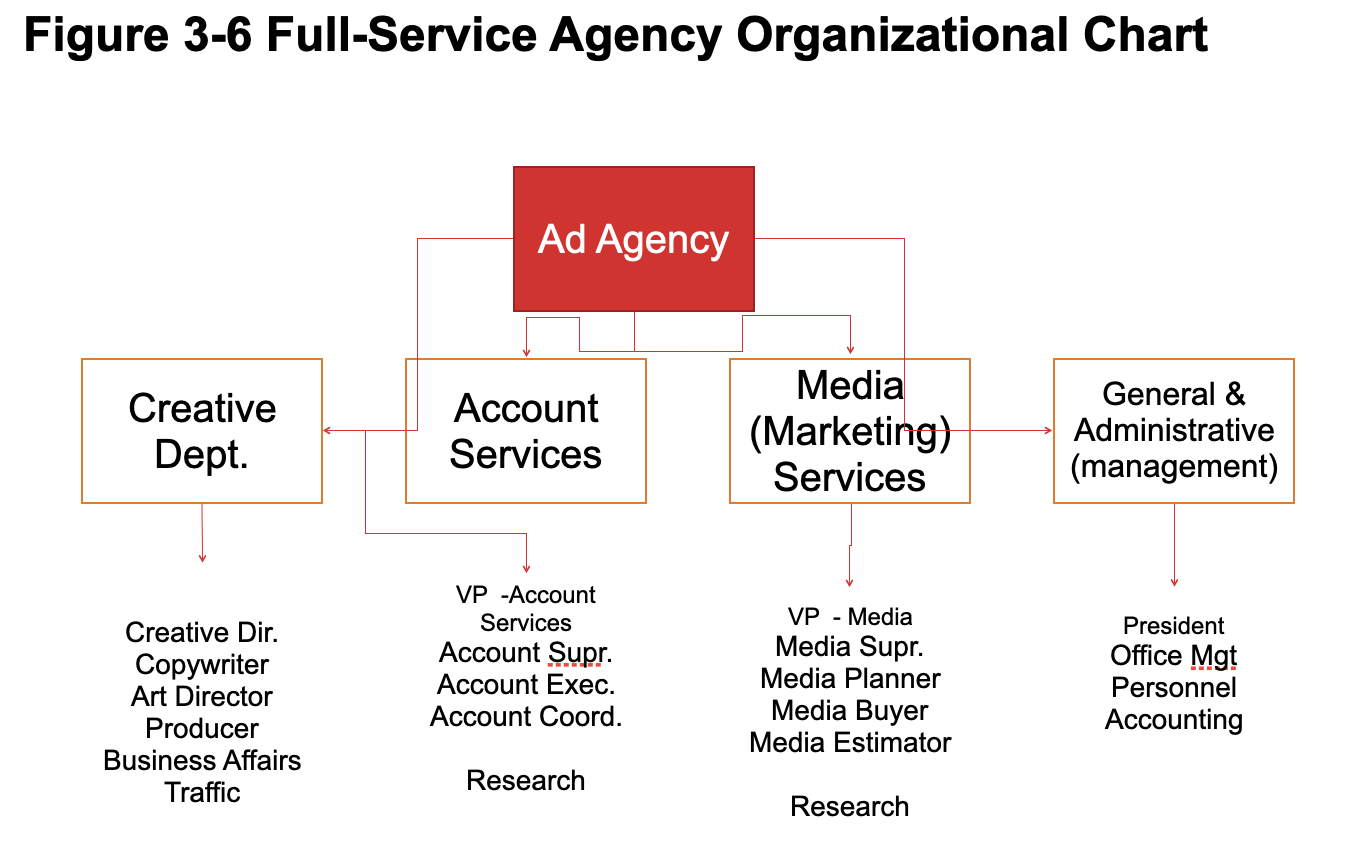
33
New cards
15% of placed media
cost of ad: $500 (gross cost = what's paid)
agency commission: $75
net cost: $425 (how much media company earns)
cost of ad: $500 (gross cost = what's paid)
agency commission: $75
net cost: $425 (how much media company earns)
Standard Agency Commission
34
New cards
problem recognition
--> info search
--> alternative evaluation
--> purchase decision
--> post purchase evaluation
--> info search
--> alternative evaluation
--> purchase decision
--> post purchase evaluation
Consumer Decision Making Process/Model
35
New cards
internal: info retrieval that involves recalling
- past experiences
- info regarding various purchase alternatives
external: info from external sources
- internet, personal, public sources
- personal experience
- past experiences
- info regarding various purchase alternatives
external: info from external sources
- internet, personal, public sources
- personal experience
Information Search – internal vs external
36
New cards
exposure: how much you allow yourself to see
→attention: choosing to focus attention
→comprehension: diff interpretation (attitudes, beliefs, experiences, etc.)
→ retention: memory
→attention: choosing to focus attention
→comprehension: diff interpretation (attitudes, beliefs, experiences, etc.)
→ retention: memory
Selective exposure/attention/comprehension/retention
37
New cards
Psychological tension experienced after a difficult purchase choice
- negative post purchase evaluation
- questioning worth/value after buying
- negative post purchase evaluation
- questioning worth/value after buying
Cognitive Dissonance
38
New cards
Sender Encodes Message through Medium Decoded by Receiver
- noise (literal/figurative)
- feedback loop (way for consumer to respond positively)
- noise (literal/figurative)
- feedback loop (way for consumer to respond positively)
SEMDR
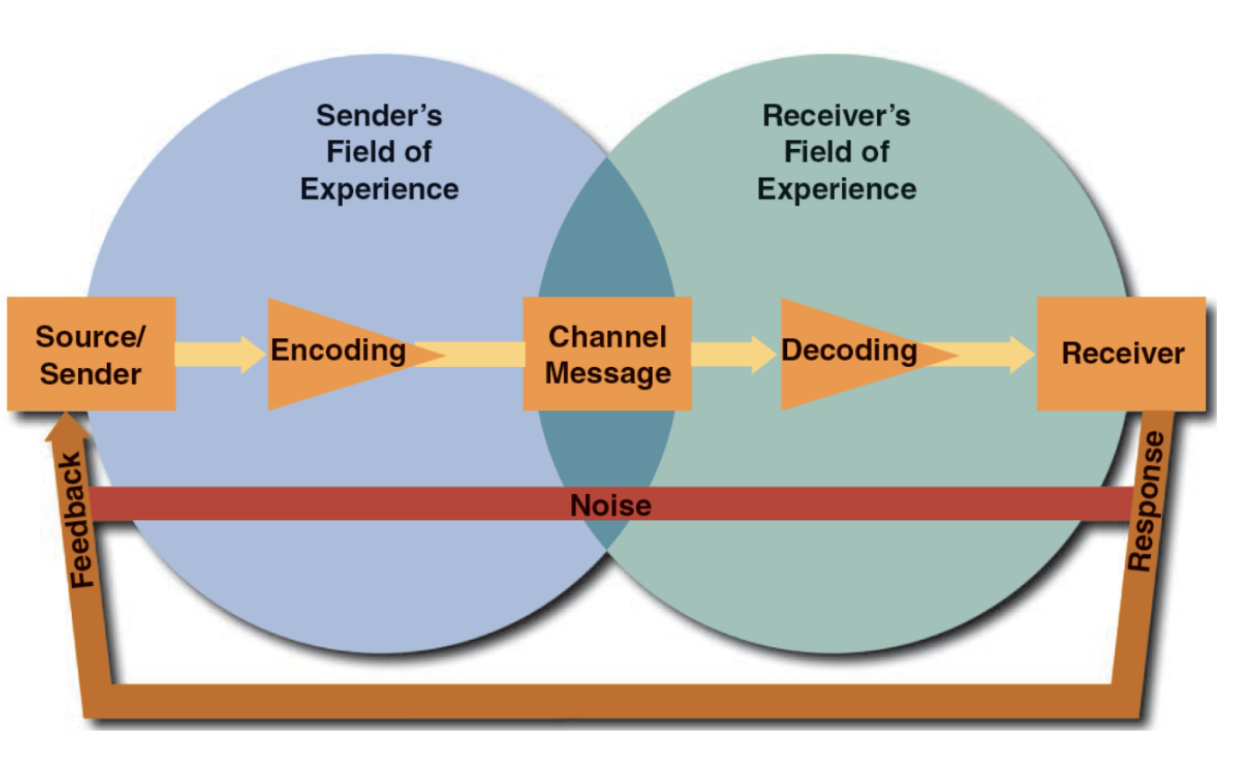
39
New cards
Facilitates communication between sender & receiver
- nonpersonal aka mass media
- personal/direct communication
- nonpersonal aka mass media
- personal/direct communication
Channel
40
New cards
form of personal/direct communication
Word-of-mouth: informal communication among consumers
- buzz/viral? marketing: generating positive WOM (hard to generate. customers have control)
Word-of-mouth: informal communication among consumers
- buzz/viral? marketing: generating positive WOM (hard to generate. customers have control)
WOM
41
New cards
AIDA: stages buyer passes through personal selling process
- Attention Interest Desire Action (what should be put in ad)
Hierarchy of Effects: stages consumer passes from no awareness-->action
1. Cognitive stage: what receiver knows or perceives about product or brand.
2. Affective stage: receiver’s feelings or affect level for brand.
3. Behavioral stage: consumer’s action toward brand.
- helps identify which stage potential buyer is in to take them to next stage
- Attention Interest Desire Action (what should be put in ad)
Hierarchy of Effects: stages consumer passes from no awareness-->action
1. Cognitive stage: what receiver knows or perceives about product or brand.
2. Affective stage: receiver’s feelings or affect level for brand.
3. Behavioral stage: consumer’s action toward brand.
- helps identify which stage potential buyer is in to take them to next stage
Response Process - AIDA & Hierarchy of Effects: Cognitive, Affective, Behavioral
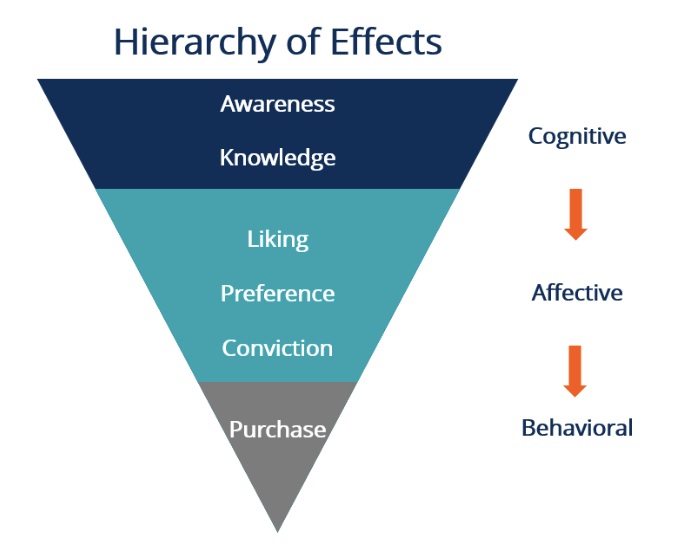
42
New cards
pros:
- draws attention whether you like them or not
cons:
- celebrity outshines product so people don't remember product
- celebrity image impacts brand
- draws attention whether you like them or not
cons:
- celebrity outshines product so people don't remember product
- celebrity image impacts brand
Use of celebrities – positives and negatives
43
New cards
• Primacy effect: info presented first most effective
• Recency effect: arguments presented last most persuasive
• Recency effect: arguments presented last most persuasive
Primacy/Recency Effect
44
New cards
1. Fear
2. Humor
3. Sex (aesthetic)
4. Rational
5. Bandwagon
2. Humor
3. Sex (aesthetic)
4. Rational
5. Bandwagon
5 Common Appeals
45
New cards
Vision – Big picture of “what” you want to achieve as an organization
\
Mission – general statement of “how” you will achieve it
(Values – what you stand for, believe in)
\
Strategy – what message is going to say
\
Goals – general statement of what you want achieve as a result of strategy (can be intangible)
\
Objectives – turns goals into specific and quantifiable
\
Tactics / Action Plan – how to execute strategy
\
Mission – general statement of “how” you will achieve it
(Values – what you stand for, believe in)
\
Strategy – what message is going to say
\
Goals – general statement of what you want achieve as a result of strategy (can be intangible)
\
Objectives – turns goals into specific and quantifiable
\
Tactics / Action Plan – how to execute strategy
Vision, Mission, Goals, Objectives, Strategy, Tactics
46
New cards
Specific
Measurable
Attainable
Relevant/Realistic
Time-based
Measurable
Attainable
Relevant/Realistic
Time-based
S.M.A.R.T. Goals
47
New cards
marketing
- identify what's to be accomplished by marketing program
- defined in terms of specific & measurable outcomes
- quantifiable, realistic, and attainable
IMC
- statements of what aspects of IMC program will accomplish
- based on communications tasks required to deliver messages to target audience
sales
- aim to increase sales
- require economic justification
- required to produce quantifiable results (ex. ROI or sales volume)
communications objectives
- provide relevant info
- create favorable feelings toward brand
- cognitive --> affective --> conative stages
- identify what's to be accomplished by marketing program
- defined in terms of specific & measurable outcomes
- quantifiable, realistic, and attainable
IMC
- statements of what aspects of IMC program will accomplish
- based on communications tasks required to deliver messages to target audience
sales
- aim to increase sales
- require economic justification
- required to produce quantifiable results (ex. ROI or sales volume)
communications objectives
- provide relevant info
- create favorable feelings toward brand
- cognitive --> affective --> conative stages
Marketing vs. Sales vs. Communications Objectives
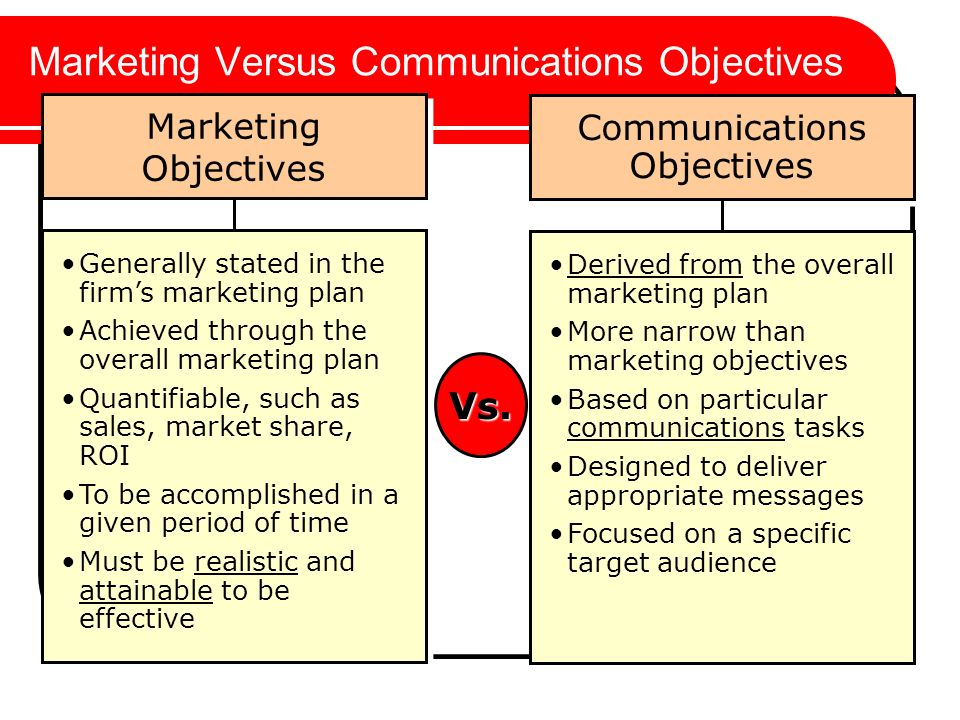
48
New cards
- tech
- competition
- economy
- product quality
- price
- distribution
- advertising & promotion
sales aren't always representative of how well ad is doing... many factors!!
- competition
- economy
- product quality
- price
- distribution
- advertising & promotion
sales aren't always representative of how well ad is doing... many factors!!
Factors Influencing Sales
49
New cards
Communication Effects Pyramid
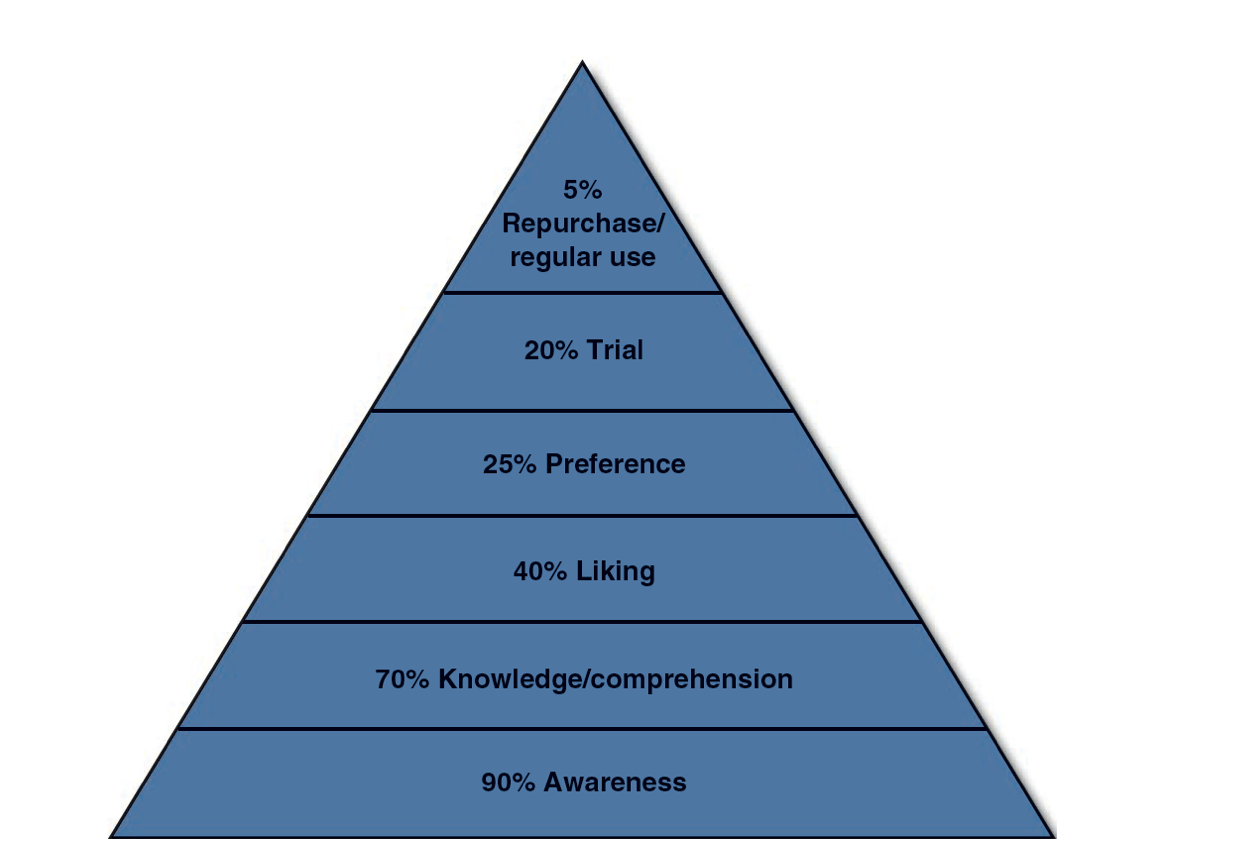
50
New cards
Purchase Funnel
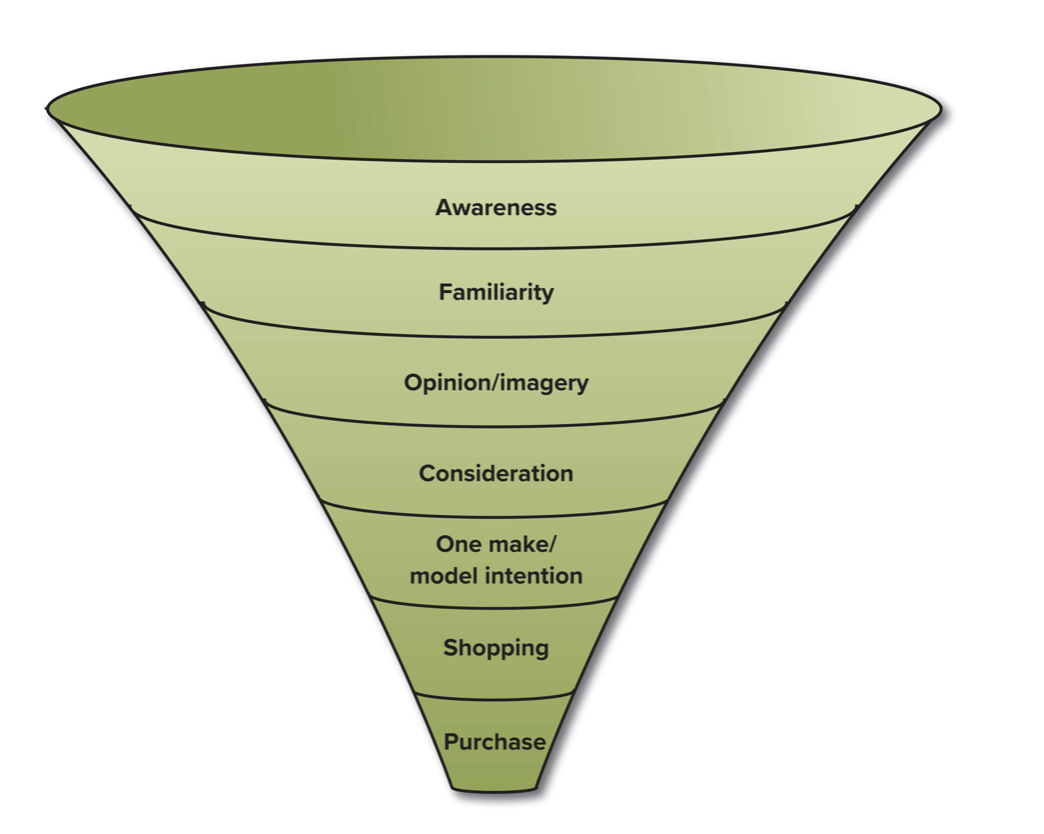
51
New cards
Defining Advertising Goals for Measured Advertising Results
communications task:
- performed by advertising
- stages: awareness.... comprehension... conviction... action
characteristics of objectives
- concrete & measurable tasks
- well-defined target audience
- benchmark measures: determine target market's present position in response stages
- specified time period
communications task:
- performed by advertising
- stages: awareness.... comprehension... conviction... action
characteristics of objectives
- concrete & measurable tasks
- well-defined target audience
- benchmark measures: determine target market's present position in response stages
- specified time period
DAGMAR - Approach to Setting Objectives
52
New cards
- company focuses on customer needs & provides
- view market from consumer POV
- starts w/ customer and builds back into brand
- view market from consumer POV
- starts w/ customer and builds back into brand
Outside In / Consumer Centric
53
New cards
1. headline
2. sub-headline
3. visual
4. logo/brand
5. slogan/tagline
6. body copy
7. call to action
8. mandatories/obligatories
Ad Anatomy
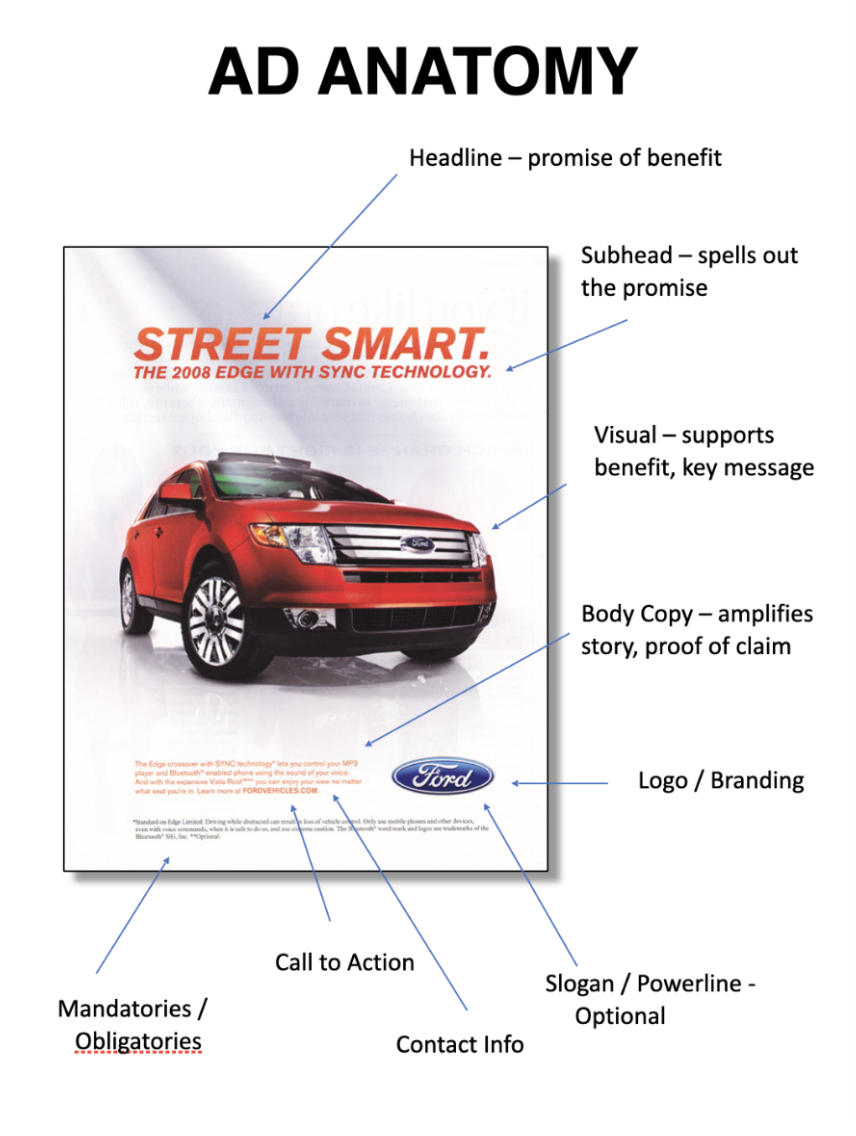
54
New cards
Emotions & benefits tend to be more powerful
Wants vs Needs, Features vs. Benefits
55
New cards
it works
What makes a great ad?
56
New cards
Research Strategy Tactics
R-S-T
57
New cards
view ad as a communication vehicle for promoting own aesthetic viewpoints and personal career objectives
copywriter: develop campaign
art director: ensure message and image are conveyed through visual aspects
production people: manage project and work with several teams; deliver finished product
copywriter: develop campaign
art director: ensure message and image are conveyed through visual aspects
production people: manage project and work with several teams; deliver finished product
Creative personnel – copywriters, art directors, production people
58
New cards
• immersion: gathering raw material & data; immersing oneself in the problem
• digestion: analyzing the info
• incubation: letting subconscious do the work
- Stop thinking about it… brain will subconsciously connect ideas
• illumination: birth of an idea
• reality/verification: studying idea & reshaping it for practical usefulness
• digestion: analyzing the info
• incubation: letting subconscious do the work
- Stop thinking about it… brain will subconsciously connect ideas
• illumination: birth of an idea
• reality/verification: studying idea & reshaping it for practical usefulness
Young/Wallas Model of the Creative Process
59
New cards
ad = 1
campaign: 2+ ads that involves common theme & elements
campaign: 2+ ads that involves common theme & elements
Ads vs. Campaigns
60
New cards
similarities in campaign
- verbal (type of language)
- visual (dark/light/cute/simple/etc.)
- aural (sound/instruments)
- attitudinal (inspiring, cool, sad, etc.)
- verbal (type of language)
- visual (dark/light/cute/simple/etc.)
- aural (sound/instruments)
- attitudinal (inspiring, cool, sad, etc.)
Verbal, visual, aura, attitudinal similarities
61
New cards
central message expressed through slogan/tagline
- research, strategy, tactics
- research, strategy, tactics
Campaign theme/creative theme
62
New cards
comp: rough layout
storyboard: series of drawings that present a proposed commercial’s visual layout
scripts: written ver. of commercial
- provides detailed description of video & audio content.
storyboard: series of drawings that present a proposed commercial’s visual layout
scripts: written ver. of commercial
- provides detailed description of video & audio content.
Comps, scripts, storyboards
63
New cards
doc that specifies key elements of creative strategy & serves as basis for communication between client & advertising agency
1. Basic problem/issue communication must address or solve
2. Communication objectives
3. Target audience
4. Insights to drive creative work (client gives info ex. Brand cares about humor)
5. Key benefits or major selling idea to communicate
6. Reason to believe/supporting info
7. Tone and manner/brand personality
8. Deliverables (what is needed and when)
9. Measures of success (should be tied back to objectives)
1. Basic problem/issue communication must address or solve
2. Communication objectives
3. Target audience
4. Insights to drive creative work (client gives info ex. Brand cares about humor)
5. Key benefits or major selling idea to communicate
6. Reason to believe/supporting info
7. Tone and manner/brand personality
8. Deliverables (what is needed and when)
9. Measures of success (should be tied back to objectives)
Creative Brief
64
New cards
User generated content (ex. heinz asked customers to draw ketchup or contests, crowdsourcing, social media)
UGC
65
New cards
Pre-production, production, post-production
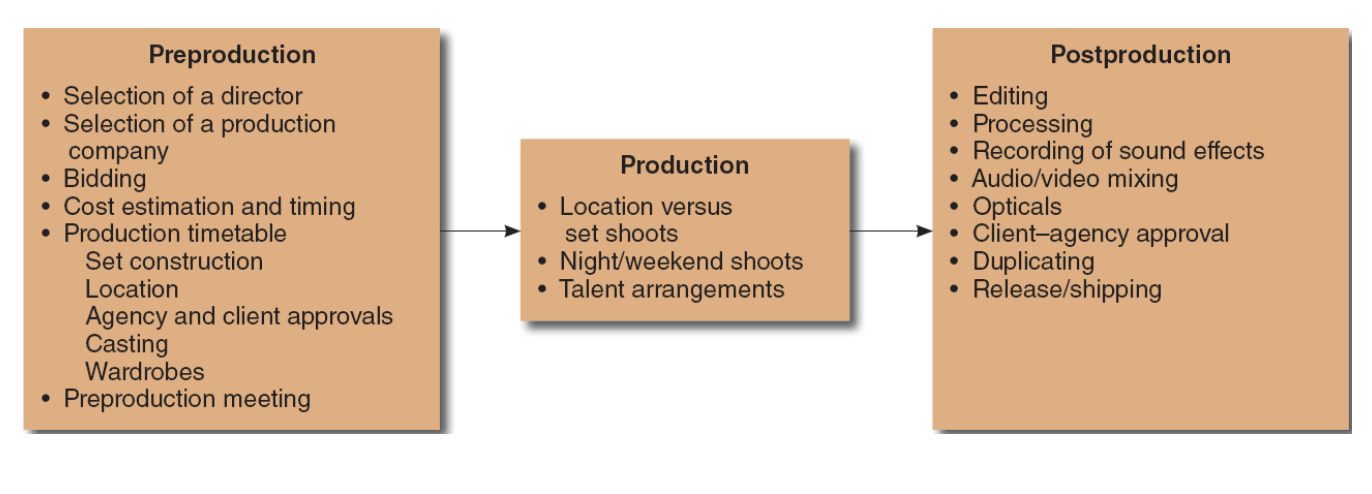
66
New cards
strengths:
* reaches larger audience than any other medium
* visual & sounds grab people’s attention and attaches a personality to the brand
weaknesses:
* most expensive type of advertising
* people might not be paying attention; distractions
* reaches larger audience than any other medium
* visual & sounds grab people’s attention and attaches a personality to the brand
weaknesses:
* most expensive type of advertising
* people might not be paying attention; distractions
strengths & weaknesses of TV
67
New cards
strengths:
* natural segmentation by station so it’s easy to target geographically
* no visuals may be a weakness but mental imagery may be a huge advantage (audience’s imagination & how you say certain things to paint that image)
* very flexible - advertising message can change just before broadcast time
weaknesses:
* audience may be passively listening as they drive
* no visual elements
\
* natural segmentation by station so it’s easy to target geographically
* no visuals may be a weakness but mental imagery may be a huge advantage (audience’s imagination & how you say certain things to paint that image)
* very flexible - advertising message can change just before broadcast time
weaknesses:
* audience may be passively listening as they drive
* no visual elements
\
strengths & weaknesses of radio
68
New cards
strengths:
* data rich medium
* convenient; people can quickly “enter” the store
* can buy as many impressions you want
weaknesses
* there are privacy issues people are concerned about
* one of the most oversaturated mediums
* reliance on technology; ad might not show up because of a slow computer
\
search ads
strength: strike while the iron’s hot; advertising exactly what the person is looking for
disadvantage: limited amount of info you can give with little words & no visuals
* data rich medium
* convenient; people can quickly “enter” the store
* can buy as many impressions you want
weaknesses
* there are privacy issues people are concerned about
* one of the most oversaturated mediums
* reliance on technology; ad might not show up because of a slow computer
\
search ads
strength: strike while the iron’s hot; advertising exactly what the person is looking for
disadvantage: limited amount of info you can give with little words & no visuals
strengths & weaknesses of internet
69
New cards
strengths:
* relevant audience; people buy what they’re interested in so it’s like natural targeting
* touch smell sight experience
* quality of reproduction is great for magazines; travel, food, jewelry looks really good
weaknesses:
* quality of reproduction is bad for newspapers
* magazines take along time to produce compared to newspapers (long lead time)
* hard to measure effectiveness because readership is an overestimate
* relevant audience; people buy what they’re interested in so it’s like natural targeting
* touch smell sight experience
* quality of reproduction is great for magazines; travel, food, jewelry looks really good
weaknesses:
* quality of reproduction is bad for newspapers
* magazines take along time to produce compared to newspapers (long lead time)
* hard to measure effectiveness because readership is an overestimate
strengths & weaknesses of print
70
New cards
strengths:
* it’s large size makes it eye catching
* cost effective brand awareness
* builds up frequency quickly because people pass by it a lot (ex. popular freeway)
weaknesses:
* difficult to measure/evaluate the impact it has on sales
* hard to remember contact information because of short exposure time
* the primary focus is driving
* it’s large size makes it eye catching
* cost effective brand awareness
* builds up frequency quickly because people pass by it a lot (ex. popular freeway)
weaknesses:
* difficult to measure/evaluate the impact it has on sales
* hard to remember contact information because of short exposure time
* the primary focus is driving
strengths & weaknesses of OOH
71
New cards
strength:
* can hold a lot of information
* brand retention; easy to remember what you read/saw
* you need information like their address to mail it so it’s highly targeted
* touch point because people need to look at it before throwing it out incase it’s important SO it has a high open rate
weakness:
* printing & postage is costly
* requires personal information
* it’s not instantaneous
* can hold a lot of information
* brand retention; easy to remember what you read/saw
* you need information like their address to mail it so it’s highly targeted
* touch point because people need to look at it before throwing it out incase it’s important SO it has a high open rate
weakness:
* printing & postage is costly
* requires personal information
* it’s not instantaneous
strengths & weaknesses of direct mail
72
New cards
strengths:
* like direct marketing you know exactly who’s seeing it because you need their email to send it
* permission-based so those people allowed you to email them meaning it’s these people are likely interested in the product/service; highly targeted
* easy to share email content; WOM
* can be sent to a ton of people with ease & little cost
* strengthens relationship with customers with new leads & reminders
weaknesses:
* overlooked because there are so many emails to look at. it’s easy to delete
* spam may irritate people
* easy to unsubscribe
* fierce competition; hard to stand out with so many emails
* message may be undelivered because it may be filed under “spam”
* design problems; changes based on different devices
* like direct marketing you know exactly who’s seeing it because you need their email to send it
* permission-based so those people allowed you to email them meaning it’s these people are likely interested in the product/service; highly targeted
* easy to share email content; WOM
* can be sent to a ton of people with ease & little cost
* strengthens relationship with customers with new leads & reminders
weaknesses:
* overlooked because there are so many emails to look at. it’s easy to delete
* spam may irritate people
* easy to unsubscribe
* fierce competition; hard to stand out with so many emails
* message may be undelivered because it may be filed under “spam”
* design problems; changes based on different devices
strengths & weaknesses of email
73
New cards
TVHH = TV Households
\
households using television (HUT) x share = rating
\
show's __rating__ is the percentage of all possible TV households or viewers in the country, its __share__ is the percentage of households or viewers actually watching TV at the time.
\
households using television (HUT) x share = rating
\
show's __rating__ is the percentage of all possible TV households or viewers in the country, its __share__ is the percentage of households or viewers actually watching TV at the time.
how do you measure rating point? (tv ratings)
\
what does TVHH \* HUT stand for?
\
what is a share? rating?
\
what does TVHH \* HUT stand for?
\
what is a share? rating?
74
New cards
average audience
\
measures listeners for radio
\
Average over entire radio (spikes at different times)
\
measures listeners for radio
\
Average over entire radio (spikes at different times)
what is AA and what does it measure?
75
New cards
?? measures audience for TV, radio, newspapers, etc.
Nielsen
76
New cards
average quarter hour
\
average number of people listening for 5 min straight (audiences come and go)
\
average number of people listening for 5 min straight (audiences come and go)
AQH
77
New cards
telephone directories of businesses
what is yellow page advertising
78
New cards
Circulation: how many issues distributed
\
total readership: how many read (higher than circulation because it’s estimated)
\
passalong: first person + others
\
Daily Effective Readership: average number of people who were potentially exposed to a display/billboard
\
total readership: how many read (higher than circulation because it’s estimated)
\
passalong: first person + others
\
Daily Effective Readership: average number of people who were potentially exposed to a display/billboard
circulation, total readership, passalong, DEC
79
New cards
internet ads
viewers/visitors, page views, duration of visit
80
New cards
pay per click
PPC
81
New cards
cost per 1000
\
cost/audience
\
cost/audience
CPM
82
New cards
?? buy most ad views w/ lowest cost
“buy most with the least”
83
New cards
• ease of travel, international banking, global communications
* Money transfer is easy
• less language barrier
• cultural mixing
• internet access and commerce
• global sourcing of product
• technology
• growing global economics
* Money transfer is easy
• less language barrier
• cultural mixing
• internet access and commerce
• global sourcing of product
• technology
• growing global economics
international marketing & advertising… reasons for rise
84
New cards
cultural, values, norms. legal, pricing, shipping
\
\
issues w/ international marketing
85
New cards
globalized, localized, glocalizing
3 types of international advertising
86
New cards
* Pro: provide info, encourage higher standard of living, helps new firms enter market, creates job, promotes competition, lowers prices; economically good
* Cons: more propaganda than info, creates consumer needs & faults, promotes materialism insecurity & greed
* Cons: more propaganda than info, creates consumer needs & faults, promotes materialism insecurity & greed
ethics - arguments for & against?
87
New cards
Fair Housing Act (Civil Rights Act) prohibits discrimination in housing-related transactions, including advertising, based on race, color, religion, national origin, sex, disability, and familial status (known as “protected classes”).
protected classes
88
New cards
corporate social responsibility
\
modern proactive approach
\
modern proactive approach
CSR
89
New cards
1. Trustworthiness
2. Fairness
3. Respect
4. Responsibility
5. Caring
6. Citizenship
Remember: T/F? R2 C2
6 pillars of corporate citizen
90
New cards
in anything you do consider 3 things: people, planet, profit
triple bottom line
91
New cards
John Stuart Mills; Utilitarianism - do the most good OR do the least harm
\
Immanuel Kant; Do the Right Thing - “categorical imperative”
\
Joseph Fletcher - Situational Ethics
\
Immanuel Kant; Do the Right Thing - “categorical imperative”
\
Joseph Fletcher - Situational Ethics
3 philosophies
92
New cards
legal, illegal, unlawful (no law that makes it legal/illegal)
\
there’s def more…
\
there’s def more…
legal issues
93
New cards
for creative/original work
• music, stories, screenplays, films, television, websites
• don’t need to pay for protection; copyright moment you create
\
copy = creative
• music, stories, screenplays, films, television, websites
• don’t need to pay for protection; copyright moment you create
\
copy = creative
copyright
94
New cards
• products, designs, machinery, formula, patent “pending”
\
patent = product = pending
\
patent = product = pending
patent
95
New cards
• identity, logos, name/symbol, ™ (means you want a trademark), ® (registered trademark) protected but create protection by taking action
• were trademarks but not protected: aspirin, yoyo, cellophane, nylon, escalator
• were trademarks but not protected: aspirin, yoyo, cellophane, nylon, escalator
trademark
96
New cards
regulations range from industry (trade groups), federal, local, city, county, state, etc.
regulation
97
New cards
corporate social responsibility
self regulation
98
New cards
Federal Trade Commission regulate business
\
Federal Communications Commission regulate TV & internet (which is owned by the people)
\
Food & Drug Administration
\
Federal Communications Commission regulate TV & internet (which is owned by the people)
\
Food & Drug Administration
FTC, FCC, FDA
99
New cards
Federal Trade Commission Act + Pure Food & Drug Act
* Forced us to be more honest in advertising
* Can’t lie about product, what’s on label, have honest business affairs
* Forced us to be more honest in advertising
* Can’t lie about product, what’s on label, have honest business affairs
FTC Act
Pure Food & Drug Act
Pure Food & Drug Act
100
New cards
* Puffery “the best'' allowed to a certain extent … can claim yourself but if you state someone else does then you need evidnece
puffery